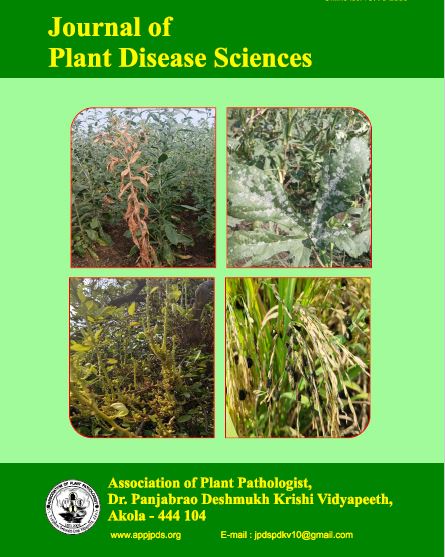SCREENING OF CUCUMBER CULTIVARS TO DOWNY MILDEW CAUSED BY IN NATURAL FIELD CONDITIONS
DOI:
https://doi.org/10.48165/jpds.2025.20.01.14Keywords:
Cucumber, Downy mildew, Pseudoperonospora cubensis, Screening, ResistanceAbstract
Downy mildew, caused by Pseudoperonospora cubensis, is a major limiting factor in cucumber production, especially during the Kharif season under humid conditions. The present study was carried out to assess the field resistance of twelve cucumber cultivars against downy mildew during the Kharif 2023 season. Observations were made on the time of first disease appearance and percent disease index (PDI) at different crop stages. The disease first appeared between 34 to 47 days after sowing (DAS), with Lalit-22 showing the earliest and Pant Khira-1 the latest onset. At 40 DAS, nine cultivars showed no symptoms, while Lalit-22, Honey, and Netra-007 showed early infections with PDIs of 15.66%, 12.06%, and 14.33%, respectively. By 70 DAS, disease severity had progressed in all cultivars, with final PDI values ranging from 23.85% to 71.66%. Based on disease response, Ankur-07 and Gujarati Nirmala-2 were rated as moderately resistant, whereas Lalit-22, Honey, and Netra-007 were found susceptible. The remaining cultivars were moderately susceptible. The findings underscore the importance of delayed disease onset and reduced final severity as indicators of resistance. Cultivars Ankur-07 and Gujarati Nirmala-2 may be valuable genetic resources for breeding programs aimed at improving downy mildew resistance in cucumber.
References
APSnet, 2009: Downy mildew of cucurbits. Retrieved from: https://www.apsnet.org
Butler, E. J., 1918: The downy mildew of cucumber in Punjab. Indian Phytopath., 5: 47–50.
Cohen, R., Dita, M., and Gubba, A., 2015: Resistance to downy mildew in cucumbers: A review. Plant Dis., 99(8): 1034–1043.
Colucci, G. and Holmes, G., 2010: Integrated management of cucurbit diseases in India. Plant Dis. Control, 31: 345–348.
de Candolle, A., 1885: Origin of Cultivated Plants. Biblio Bazaar.
FAO, 2019: FAOSTAT: Statistical Database. Food and Agriculture Organization of the United Nations.
Holmes, G., Savory, C., and Niks, R., 2015: New strategies for breeding downy mildew resistant cucumbers. Eur. J. Plant Pathol., 141: 723–735.
Jamadar, P. and Desai, U. S., 1997: Screening methods for the resistance of cucurbits to downy mildew. Indian Phytopath., 50(1): 55–60.
Lebeda, A. and Cohen, R., 2011: Downy mildew of cucumber: History, distribution, and control measures. Cucurbit Res. J., 20: 13–20.
Lebeda, A. and Schwinn, F., 1994: Studies on the host specificity of Pseudoperonospora cubensis in cucurbits. Plant Pathol. J., 43: 521–528.
Savory, C., Coon, B., and Nischol, S., 2011: The future of fungicide use in managing downy mildew in cucumbers. Plant Prot. J., 44: 205–210.
Wahul, S., 2018: Downy mildew and its management in cucumber in Western Maharashtra. Indian Hort. J., 13(2): 145–150.
Weng, Y., Liao, J., and Huo, J., 2020: Historical domestication of Cucumis sativus: A genetic perspective. Plant Genet., 12(4): 455–461.
Wheeler, B. E. J., 1969: Disease and the resistance of cucurbits to downy mildew. Plant Dis. Rep., 53: 621–627.

